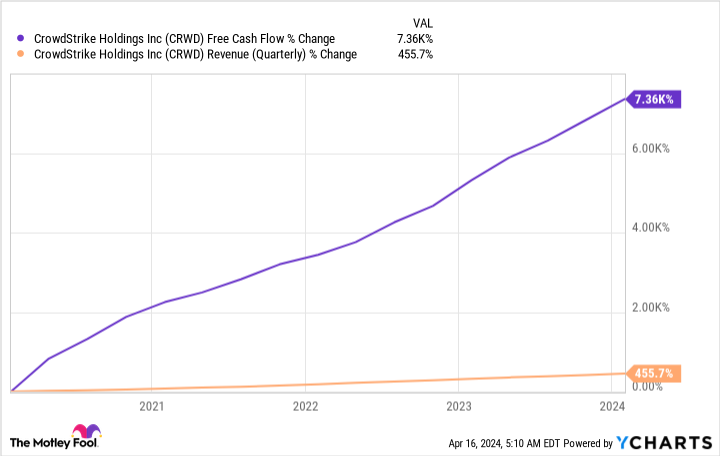These companies have a stronghold on their respective industries that should drive growth for the foreseeable future.
The tech industry has dominated stock-market gains for quite some time now, and it’s been even more noticeable with the emergence of artificial intelligence (AI). Because of the high-growth opportunities many tech companies provide, it makes sense why many growth-seeking investors go the tech route.
Regardless of the opportunities that tech stocks offer, it’s still important that investors keep a long-term mindset and not approach them expecting to get rich quickly.
For investors with $5,000 available to invest, the following three options are good long-term choices, and you can divide your money evenly among them. They each operate in different tech industries but are market leaders in their own right.
1. Amazon
From an online bookstore to a tech conglomerate, Amazon (AMZN -2.40%) is arguably the prime example of growth stocks in the tech industry. A $1,000 investment in Amazon at its May 1997 initial public offering (IPO) would be worth over $1.8 million today.
Amazon rose to dominance because of its e-commerce business but has since become the leading cloud service provider with its platform, Amazon Web Services (AWS). It’s also made a mark in the entertainment industry with its Prime Video.
E-commerce accounts for most of Amazon’s revenue, but AWS is responsible for much of the company’s profits. Both factors explain why the company is poised to be a force for the long haul. Regarding e-commerce, it’s beginning to leverage its logistics network, which cost the company billions to develop, to generate new income streams with its Supply Chain by Amazon.
Supply Chain by Amazon is a fully automated set of supply chain services that allow sellers to use the company’s intricate logistics, warehousing, distribution, fulfillment capabilities, and transportation (including international). Being able to grow from its own e-commerce business to serve the broader e-commerce market will only strengthen Amazon’s stronghold on the industry.
2. CrowdStrike
CrowdStrike (CRWD -3.38%) is one of the premier cybersecurity companies in the world and seems to be in the right place at the right time. The need for cybersecurity is increasing as the world becomes more digital.
According to IBM‘s “Cost of a Data Breach Report 2023,” the average cost of a data breach globally is $4.45 million, and 51% of organizations plan to increase their cybersecurity spending as a result. That’s just data breaches, too, but plenty of other cyberattacks can threaten a company’s business.
IBM’s report also mentions that organizations which use AI and automation to fight this problem save $1.76 million, compared to organizations that don’t. This works in CrowdStrike’s favor, as the company is one of the pioneers of solely using AI to fight cyberattacks.
There’s no doubt CrowdStrike’s platforms are effective — the business results speak for themselves. Around 27% of its clients use seven or more of the products in its ecosystem (called “modules”), 43% use six or more, and 64% use five or more. This has helped the company’s free cash flow skyrocket during the past few years.
CRWD Free Cash Flow data by YCharts.
CrowdStrike can still cover a lot more ground in the cybersecurity industry. According to the company and market intelligence firm IDC, the AI-native cybersecurity market is estimated to grow from $100 billion this year to $225 billion by 2028. Of course, CrowdStrike won’t capture all of it, but it’s poised to be a company that benefits largely from this expected growth.
3. Meta Platforms
Despite some well-documented public relations mishaps, Meta Platforms (META -3.55%) has been a gift to its investors over the past one-and-a-half years. The stock price is up over 450% since its November 2022 slump.
The owner of Facebook, Instagram, WhatsApp, and Messenger has positioned itself as a go-to platform for advertisers looking to get their products and services in front of the eyes of Meta’s 3.98 billion month active users (MAUs). It’s been working wonders for the company recently, too, with its financial health as good as it has ever been by many standards.
Meta has always been a revenue cash cow, but recently, its net income has surged. In 2023, Meta’s net income was over $39 billion, up 69% from 2022.
META Revenue (Quarterly) data by YCharts.
Meta’s net income growth relative to its revenue growth shows the company is beginning to operate more efficiently and use its capital more effectively. Meta declared a dividend in February for the first time in its history.
The company’s quarterly dividend is $0.50 per share, and I think it wouldn’t have started paying it at this point if it didn’t intend to increase it annually. Meta is far from a dividend investor’s dream, but it can be a true two-for-one for long-term investors.
John Mackey, former CEO of Whole Foods Market, an Amazon subsidiary, is a member of The Motley Fool’s board of directors. Randi Zuckerberg, a former director of market development and spokeswoman for Facebook and sister to Meta Platforms CEO Mark Zuckerberg, is a member of The Motley Fool’s board of directors. Stefon Walters has no position in any of the stocks mentioned. The Motley Fool has positions in and recommends Amazon, CrowdStrike, and Meta Platforms. The Motley Fool recommends International Business Machines. The Motley Fool has a disclosure policy.








